KAS Astrology Lessons
Krushnaji had written a series of lessons on KAS during 2000-2002 and he made them available to KAS Yahoo Group members. Mrs. Donna Quinn was kind enough to proof read the lessons and fix typos and grammar to make the lessons easily comprehensible. I am reproducing the KAS lessons here to support new KAS students. The only change I have made is to provide screen shots of charts from online KAS software which uses an improved KAS ayanamsa value than the one that students were using during 2000-2002.
Lesson 7: Krushna's Planetary Strengths Worksheet
Krushna’s planetary strengths worksheet explained in this lesson gives an accurate summary of the overall strengths of each of the planets as well as their relative strengths to each other.
Comments: This is one of the most important KAS Lessons provided by Krushnaji. Students should understand this lesson well and practice creating the worksheet manually. The online KAS software provides a quick summary of overall strength for each planet for each of 12 houses. However, understanding the mechanics of how the strengths are calculated is important for students.
Also, it is important to know that Krushnaji corrected the method of strength calculation after this lesson was shared. I have provided the set of changes from original method as commentary in this lesson to avoid any confusion.
Planets receiving LESS than 12 points in row 18 are considered MALEFIC. Planets receiving MORE than 12 points in row 18 will give BENEFIC results for the indicated event as listed in House B.
The timed event can be judged by the planets receiving the most points and the results can be experienced in the sub period of such planets.
The full worksheet in color is given below, so that you will be able to print out the whole worksheet on one separate page and use it as a template for future charts if you choose to do it manually.
Following the blank worksheet template, I will present an Example Worksheet with all the data filled out in RED type. (Blank boxes will be represented here by a bold RED dash.) Then I will explain in detail the process of how to go through each Row of the Worksheet with simple illustrations as I go along to make it clear as to how I arrive at the final strengths of the planets.
Krushna's Planetary Strengths Worksheet
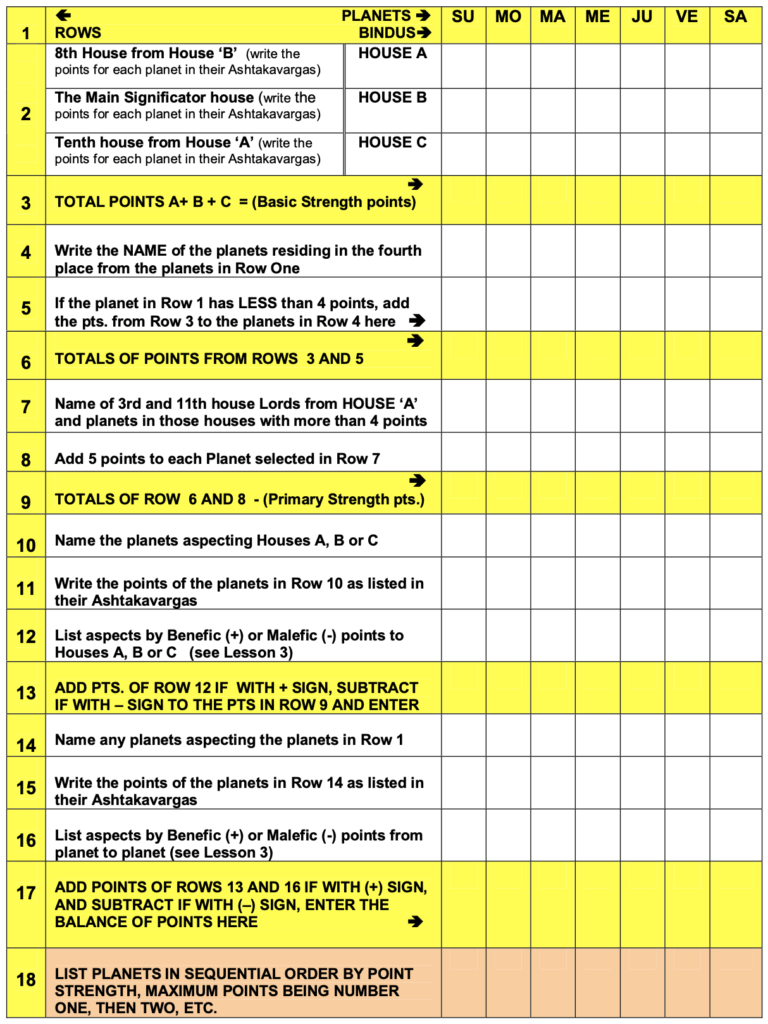
Example Worksheet for Marriage. Details on calculation method provided below table
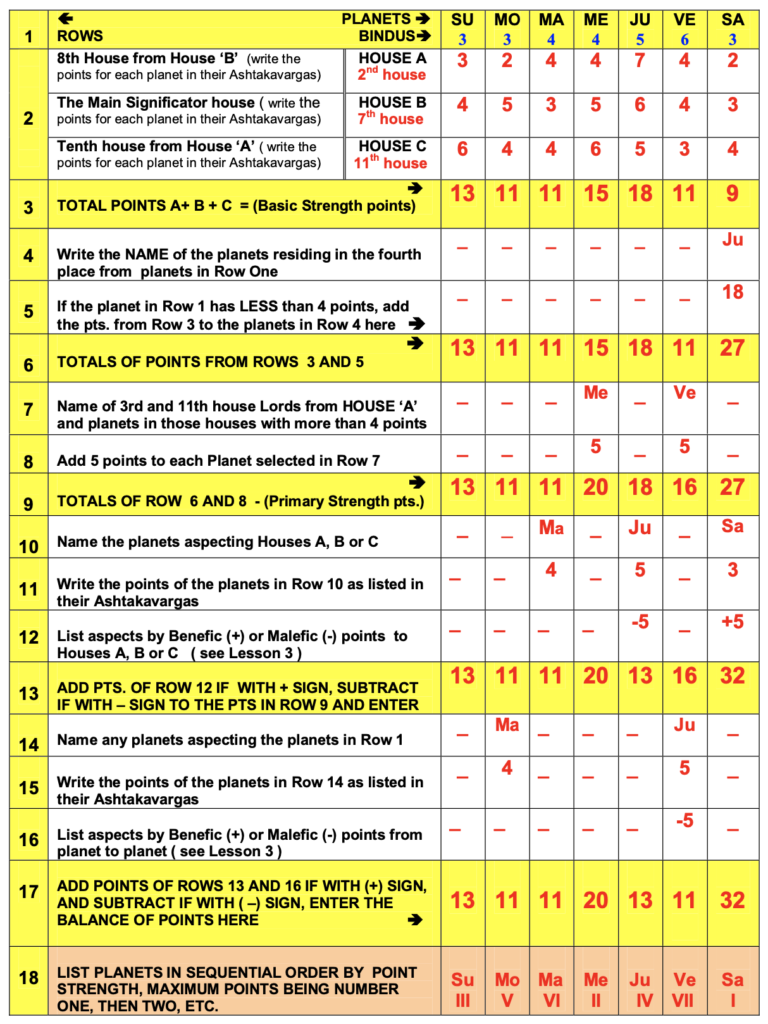
Analysis of the Worksheet Example
Below is the natal chart for this example worksheet with just the points of each planet shown in its proper house as well as the Main Upachaya houses for Marriage (yellow shaded houses)
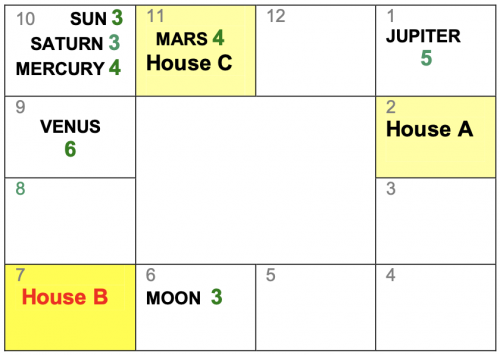
Birth data: Female, April 10, 1966; 12:08pm; 19N36, 77E40; Time zone 5:30. Krushna’s Ayanamsha 22:22:16; (Mean Nodes); Krushna Ayanamsha Diff; 01:00:24 Open chart in online KAS software
ROW 3: The objective is to total up all the points from each planet in the Upachaya houses and list them in the worksheet as noted from the Ashtakavarga table below. The numbers in RED indicate the planet’s natal positions in the chart.
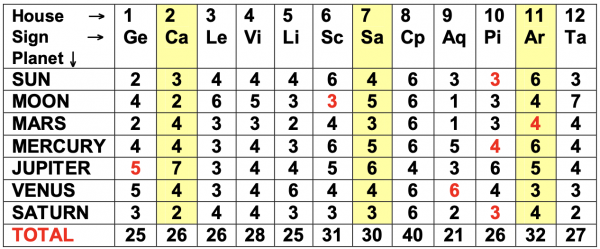
Comments: Please note that the table above matches the Ashtakavarga table in Online KAS software. Only difference is that houses are shown as rows and planets as columns in online KAS software.
Once you total up the points in Row 3, you will get the Basic Strength points of the planets for that particular event, which in this case is Marriage.
Comments: Please note that results on Row #3 of example worksheet match the values in “Basic Strength” table for House #7 in Online KAS software.

Jupiter is in the fourth place from Saturn only, or you can say that Saturn, is in the tenth house from Jupiter, either way. This is known as a ‘fourth-tenth’ house relationship. Again, according to the rule, ‘If two planets have an equal amount of points, then the natural malefic planet among them will get the power from the planet in the fourth place’, and as we can see, Saturn and the Sun have an equal amount of the lowest points in the house. We now have to choose which one will get the benefic points from Jupiter in the fourth house. Since the Sun is friendlier to the lord of the sign, Saturn would be the one to choose as the more natural malefic in this case. Because of this unique fourth-tenth house relationship in which Jupiter has more than 4 bindus and Saturn has less than 4, we will be able to ADD the total points so far, from Jupiter in Row 3, which is 18, to the 9 points of Saturn, also in Row 3. We then put those 18 points underneath the Saturn column in Row 5. We do not have to concern ourselves with the fact that Mercury or the Sun has less than 4 points, because they were disqualified when Saturn became the ‘elected’ malefic to receive Jupiter’s points.
Comments: Krushnaji later corrected the method. As per new method, since both Sun and Saturn have a tie and both have less than 4 points, we need to list Jupiter under both Sun and Saturn. The changes from original are marked with Green highlight.

ROW 6: These are simply the total points from Rows 3 and 5. Add them to each box.
From our studies on the Upachaya Houses in Lesson 5, we know that the lord of the 3rd and the 11th house, shaded in orange below, also plays a key role in the event as well as any planets residing in those houses with more than 4 benefic points. Since these houses only act through their lords and the planets located in them, they are known as Secondary Upachaya houses and are more indirectly involved than the Main Upachaya houses are in the outcome of the event. (Remember to count the 3rd and the 11th house lords from the Upachaya Starting point, which is House ‘A’. Upachaya houses are labeled in BLUE). As you can see below, the lord of the 11th here is Venus. So we enter it as Ve in the Venus column in Row 7. The lord of the 3rd house is Mercury, so we enter Me in its proper column as well.
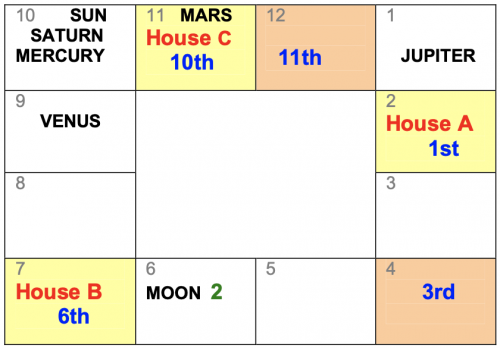
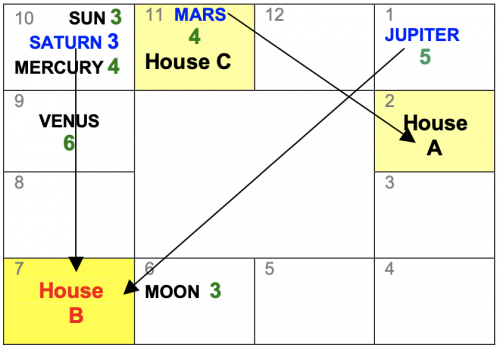
Saturn aspects or has ’10th sight’ on House ‘B’, ten houses away from itself. Mars aspects House ‘A’ four houses away from it. Finally, Jupiter aspects House ‘B’ seven houses away. These are the only planets making aspects to the Main Upachaya houses and we enter them as Sa, Ma and Ju, each under their own proper columns.
We can either go back to the Ashtakavarga chart and look at the natal positions for Saturn, Mars and Jupiter (in RED) to see that Saturn has 3 points, Mars has 4 points and Jupiter has 5 or we simply see the points in the chart above for each planet as well. Enter them into the worksheet under the proper columns as indicated.
In Lesson 3, it is noted that a planet with more than 4 benefic points will aspect in the same strength, but in a malefic manner. Similarly, any planet with LESS than 4 benefic points will aspect in a benefic manner, equal to 8 minus the points of the planet. In other words, if any planet has only 2 benefic points, then its aspect will be benefic by 8-2=6 points.
In this case, we can see that the Saturn has 3 bindu points in its house. This means that it will cast 5 benefic points (8-3=+5) on the 10th house, House B.
Mars aspects has 4 benefic points, hence it’s aspect will be considered as neutral on House A. And finally, Jupiter who has 5 points will cast 3 on the house it aspects. The points for each of these planets will be reflected in Row 12 of the worksheet.
Comments: Ju is placed in House #1 and aspects 7th house (B) with 7th aspect. 7th house sign is Sagittarius and Jupiter is lord of Sagittarius, Ju will not deduct points for own house. This is the second correction from original table. The changes from original are marked with Green highlight.

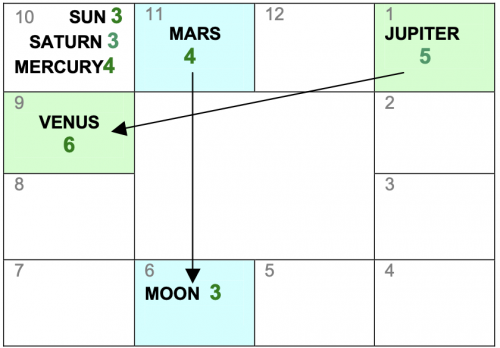
Here we can see that Mars is making an 8th house aspect to the Moon and Jupiter is making a 9th house aspect to Venus. (We can also word it to say that Mars has ë8th sightí on the Moon and Jupiter has ë9th sightí on Venus.) Accordingly, we will enter Mars as Ma in the Mars column and Jupiter as Ju in the proper column in Row 14.
This is basically the same thing as in Row 12 except that Row 12 was concerned with aspects to the Upachaya Houses only. In this row, weíre concerned with Benefic (+) and Malefic (-) point aspects from planet to planet only. As you can see from the chart below, the only planet that casts an aspect to another planet here is Mars to the Moon. But since Mars has only 4 points it is considered NEUTRAL and therefore has no effect on the Moon and cannot be included. Jupiter aspects Venus, but as it has 5 benefic points, it will aspect in a malefic manner with the same amount of points. Therefore 5 points will be deducted in this row. (see chart below).
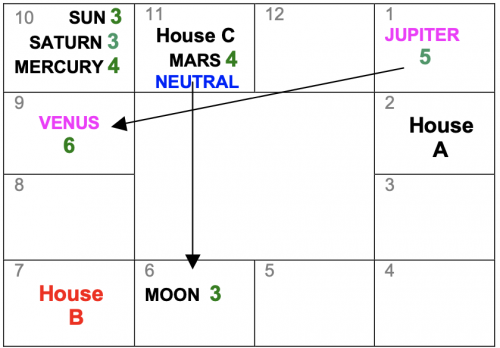
BRIEF ANALYSIS: From the results of the worksheet, we can now see that the planets are listed in strength from strongest to weakest in Row 18.
Comments: There is another correction that we need to take into account. Since, Ve is Lord of E, we do not consider Jupiter’s negative aspect on Venus. The changes from original are marked with Green highlight.
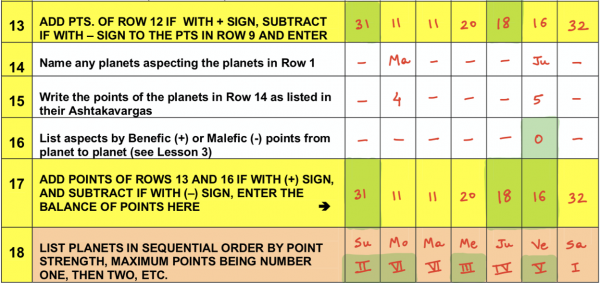
As to which planet will bring Marriage, we must consider this rule: The planets that are aspecting the Significator Houses will NOT come forward to give the results for an event. In this case, Saturn, Mars and Jupiter are all aspecting the Significator Houses. Mars is below 12 points and therefore is not considered. Jupiter, although strong with 13 points is in the lagna and aspects the 7th House of B. This leaves Saturn which although is the most powerful, will not come forward because it aspects House B. Such planets can be replaced however by Samdharmi planets. The word SAMDHARMI means ‘of the same nature’. Mercury is Samdharmi to Saturn in this chart and has 4 points where it resides in the same house as Saturn.
From the strength chart, we can easily see that Mercury is the 2nd highest planet on the list and doesn’t have any obstructions, so it CAN bring about the marriage. In fact, since it is Samdharmi to Saturn, the marriage SHOULD be performed in the MERCURY sub period. The timing of the event should always be in the sub period of one of the strong planets. The Mahadasa period lord has no effect here.
Comments: In the corrected worksheet, Mercury is 3rd highest, and Sun is second highest. However, if you check Vimshottari Dasha, Sun’s dasha comes much later than mercury. Mercury itself is very strong having 20 worksheet points for 7th house. Hence, Mercury antra gave the result.
The period from Dec 17, 1989 thru Oct 17, 1992 is the time of her Mercury sub period. This gives a very big ‘window’ of time however in which to consider, since the period is very long.
We then divide this time period into three sectors of equal proportions which comes out to 345 days for each division and will run like this:
Dec 17, 1989 to Nov 27, 1990 (First Sector) – No delay
Nov 27, 1990 to Nov 7, 1991 (Second Sector) – Moderate Delay
Nov 7, 1992 to Oct 17, 1992 (Third Sector) – Full Delay
For finding what sector it will fall into, we first have to find the status of the marriage, as to whether it will be an EARLY MARRIAGE, a MODERATE DELAY, or a FULL DELAY. (This will be dealt with more, in a later topic.)
In analyzing the planets, we have to consider the conditions of planets in the Navamsha as well as the Rasi chart as they both have equal status.

As you can see in the Navamsha chart, Jupiter goes to Libra and Venus is spoiled due to its distance from the Sun. Despite being Samdharmi to Saturn, Jupiter is in the lagna of the Rasi chart and therefore aspecting the 7th house (B). Therefore it will not be able to give marriage, but will cause a delay instead. So due to the delays of Jupiter and Venus here, the marriage can’t take place in the first sector.
This is a case of MODERATE DELAY, where the marriage was performed in the middle portion of the sub period of Mercury, falling in the sector of Nov 27, 1990 to Nov 7, 1991.
Comments: All the above calculations as well as some advanced calculations are already included in KAS worksheet in Online KAS Software. The KAS worksheet gives the final Row 18 values for each of the houses of the chart. Given below is the KAS worksheet for this current chart.
